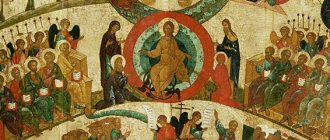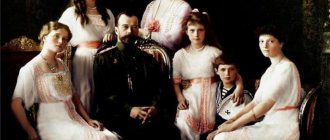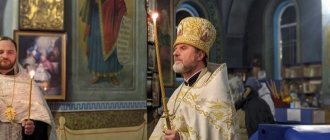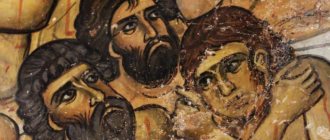Wikipedia list article
This is a dynamic list and may never meet certain completeness standards. You can help adding missing items with reliable sources.
This is a list of famous martyrs from Christianity. It only includes famous people with Wikipedia articles. Not all Christian denominations accept every person on this list as a martyr or Christian; see related articles for more complete discussion. In many Christian denominations, martyrdom is considered a direct path to sainthood, and many of the names on this list are considered saints in one or more denominations.
Content
- 1 Apostolic century - 1st century 1.1 According to the Gospels and the Acts of the Apostles
- 1.2 According to early sources
- 1.3 By tradition
- 2.1 According to early Christian tradition 2.1.1 With some historical evidence for a hundred years after the event
Is it possible to voluntarily seek martyrdom?
In answering this question, we should remember what the royal path is in the life of a Christian. The royal path is the path of judicious moderation in the fight against passions and in the acquisition of virtues, the ability to find in any activity the middle between excess and deficiency, between jealousy beyond reason and lukewarmness, etc. In other words, the royal or middle path consists in knowing your own measure . Therefore, a real martyr does not “run into” suffering, but also does not cheat his soul and does not flee. St. Gregory the Theologian wrote: “The law of martyrdom is such that, just as while sparing the persecutors and the weak, one should not go out into heroic deeds without permission, so, having gone out, one should not retreat, because the first is insolence, and the last is cowardice” (Sermon 43).
Apostolic Age - 1st century
"Martyrdom of St. Paul", Tintoretto
According to the Gospels and the Acts of the Apostles
- Holy Innocents of Bethlehem [Matthew 2:16-18]
- John the Baptist [Matthew 14:1-12]
- Stephen (Protomartyr) [Acts 7:54-60]
- Jacob son of Zebedee [Acts 12:1-2]
According to early sources
- James, brother of Jesus[1] - attested by Josephus ca. '94
- Simon Peter, first attested by Tertullian around 200.[2]
- Apostle Paul, first attested by Ignatius of Antioch probably around 110[3]
Traditionally
- Apostle Andrew[4]
- Matthew the Apostle[5] - not confirmed by modern sources
- Philip the Apostle - conflicting accounts[6]
- Apostle Thomas[7]
- Judas Thaddeus[8]
- Bartholomew - conflicting accounts[9]
- Barnabas[10]
- Simon Zelotes - Controversial Later Traditions.[11][12]
- Mark the Evangelist[13]
- Timothy[14] - not confirmed by modern sources
- Philemon[15] - not confirmed by modern sources
Early Church
See also: Persecution of Christians in the New Testament
Saint Stephen was the first martyr in the Christian tradition.[18] Judith Perkins wrote that many ancient Christians believed that “to be a Christian is to suffer.”[19]Jesus Christ died to save the souls of all who believed in him, demonstrating the ultimate sacrifice. However, he was crucified, but not formally martyred.
The teachings of Christ's apostles brought the Early Church into conflict with the Sanhedrin. In the Book of Acts, Luke describes how the early Church "began to move beyond the boundaries of early Judaism."[20] Stephen was accused of blasphemy and condemned by the Sanhedrin as a "stubborn" people who, like their ancestors, persecuted the prophets.[21]D . A. Carson and Douglas J. Moo write that Stephen was stoned to death after he was "falsely accused of opposing the temple and the law."[20][22]
In many Christian traditions, Saint Antipas is commonly known as the martyr Antipas, who was written about in Revelation 2:13. John the Apostle Traditionally it is believed that he consecrated Antipas as Bishop of Pergamon, while Domitian was the Roman Emperor. According to legend, Antipas was martyred c. 92 AD, being slowly burned alive into a brazen bull, to drive out demons that were worshiped by the locals.
The Book of Revelation calls Jesus, like Antipas, a “faithful witness” ( o Martis o Pistos
).[23][24][18]
The lives of the martyrs have become a source of inspiration for some Christians, and their relics have been honoured. Numerous crypts and chapels in the Roman catacombs testify to the early veneration of these champions of freedom of conscience. Special memorial services, at which holy Sacrifice was offered over their graves, gave rise to the time-honored custom of consecrating altars by placing the relics of martyrs within them.[5]
Age of martyrdom - 2-4 centuries.
Pope Saint Fabian and Saint Sebastian, Giovanni di Paolo The Martyrdom of Saint Albanese from a 13th-century manuscript now in the library of Trinity College, Dublin. Note the executioner's eyes falling out of his head.
According to early Christian tradition
With some historical evidence for a hundred years after the event
- Polycarp of Smyrna[16]
- Justin Martyr[17]
- Scillitanian martyrs[18]
- Perpetua and Felicity[19]
- Ptolemy and Lucius[20]
- Pothinus, Bishop of Lyon, with Blandina and several others, "Martyrs of Lyon and Vienna"[21][22]
- Papa Fabian[23]
- Saint Sebastian[24]
- Shmona and Gurya[25]
- Saint Agnes[26]
- Felix and Adauctus[27]
- Marcellinus and Peter[28]
- Forty Martyrs of Sebaste[29]
- Euphemia[30]
- Cyprian[31]
With some historical evidence more than a hundred years after the event
- Saint Alban[32]
- Ignatius of Antioch[33]
- Gelasin[34]
- Saint Pancras[35]
- Saint Valentine[36]
- Saint Petronilla[37]
Largely or completely legendary
- Saint Afra[38]
- Saint George[39]
- Januarius[40]
- Vincent of Saragossa[41]
- Saint Behnam[42]
- Saint Lucie[43]
- Lawrence of Rome[44]
- Saint Cecilia[45]
- Catherine of Alexandria[46]
- Vitus[47]
- Pelagia of Tarsus[48]
- Sophia the Martyr and her three daughters Faith, Hope and Charity[49]
The Roman Empire
Main article: Persecution of Christians in the Roman Empire
Martyrs Maximus and Theodotus of Adrianopolis, c. 985
In the first three centuries, the Christian Church experienced periods of persecution by Roman authorities. Local authorities periodically and irregularly persecuted Christians. In addition, there were several periods of persecution throughout the empire, which were directed from the seat of government in Rome.
Christians were persecuted for refusing to worship the Roman gods or pay homage to the emperor as a deity. In the Roman Empire, refusing to sacrifice to the emperor or the gods of the empire was tantamount to refusing the oath of allegiance to one's country.
The cult of saints played an important role in the process of Christianization, but in the early centuries of the Church the celebration of saints took place in secret.[16]:4 Michael Gaddis writes that “Christian experiences of violence during pagan persecution shaped ideologies and practices that led to further religious conflicts in during the fourth and fifth centuries."[25] Martyrdom was a formative experience and influenced how Christians justified or condemned the use of violence in subsequent generations.[25] Thus, the collective memory of religious suffering found in early Christian writings dealing with historical experiences of persecution, religious suffering, and martyrdom shaped Christian culture and identity.[26]
Middle Ages - from the 5th to the 15th centuries.
| This section do not quote any sources . |
- Tewdrig, 6th century.
- Sigismund of Burgundy, 524
- Edwin of Northumbria, 633 at Battle of Hatfield Chase
- Oswald of Northumbria, 642 at the Battle of Motherfield
- Projectus of Clermont, 676
- Varin of Poitiers, 677
- Dagobert II francs, 676
- Kilian, Colman, and Totnan, 689
- Fructus, valentine and engracia of Segovia, ca. 715
- Theofrid of Orange, 728 / -32 Saracens
- Porcary of Lerinsky, ca. 732 users Saracens
- Boniface, 754
- Ethelbert II of East Anglia, 794
- Martyrs of Jonah, 806 by Vikings
- Gohard of Nantes, 843 by Normans
- Roderic, Eulogius, Perfectus, Laura, Flora and Maria, Aurelius and Natalia, Nunilo and Alodia, and other Martyrs of Cordoba, 850-59
- Bertarius of Monte Cassino, 883 by Saracens
- Edmund of East Anglia, 869
- Lyudmila Bohemia, 921
- Viborada from St. Gall, 921 Magyar
- Wenceslas I, Duke of Bohemia, 935
- King Edward Martyr, 979
- Adalbert of Prague, 997 by Old Prussians
- Bruno of Querfurt, 1009
- Jovan Vladimir, 1014
- Olaf II of Norway, 1030 at Battle of Stiklestad
- Gerard Chanadsky, 1046
- Stanislav Shchepanovsky, 1079
- Canute IV of Denmark, 1086
- William Norwich, 1144 (cult suppressed)
- Eric IX of Sweden, 1161
- Thomas Becket, 1170 - The most famous martyr of the Middle Ages.
- Berard of Carbio and companions, 1220
- Serapion of Algiers, 1240
- Buzad Hahot, 1241
- Peter of Verona, 1252 author of Cathars - Canonized 11 months after death; the fastest in history.
- Martyrs of Sandomierz, 1260
- Antonio Pavoni, 1374 by Waldensian
- King Lazarus, 1389
- Nikolay Tavelich, 1391
- John of Nepomuk, 1393
- Jan Hus (1415) and Jerome of Prague (1416) - executed for heresy by a Catholic. Constance Cathedral
- Joan of Arc, 1431 - executed for heresy by an English Roman Catholic tribunal; rehabilitated by French investigation in 1456
Origin
Martyrdom of San Acacio
(Acacius, Agathus, Agathius). From Triptych. Museo del Prado
Religious martyrdom is considered one of the most significant contributions of Second Temple Judaism to Western civilization. The concept of voluntary death for God is believed to have arisen as a result of the conflict between King. Antiochus Epiphanes IV and the Jewish people. 1 Maccabees and 2 Maccabees list numerous martyrdoms suffered by Jews resisting Hellenization from their Seleucid overlords, executed for crimes such as keeping the Sabbath, circumcising one's children, or refusing to eat pork or meat sacrificed to foreign gods. With a few exceptions, this assumption has persisted from the early Christian period to the present day, accepted by both Jews and Christians.
According to Daniel Boyarin, there are "two main theses regarding the origins of Christian martyrology, which [can be called] Friend's thesis and Bowersock's thesis." Boyarin characterizes Friend's WHC view of martyrdom as the emergence of "Judaism" and Christian martyrdom as a continuation of this practice. Friend argues that the Christian concept of martyrdom can only be understood as deriving from Jewish roots. Friend characterizes Judaism as a "religion of martyrdom" and that it was this "Jewish psychology of martyrdom" that inspired Christian martyrdom. Friend writes: “In the first two centuries AD there was a living pagan tradition of self-sacrifice for a cause, a willingness if necessary to defy an unjust ruler, which existed alongside the developing Christian concept of martyrdom inherited from Judaism.”[6]
In contrast to Friend’s hypothesis, Boyarin describes G.V. Bowersock's view of Christian martyrology as being completely unrelated to Jewish practice, being instead "a practice that grew up in an entirely Roman cultural environment and was then adopted by the Jews." Bowersock argues that the Christian tradition of martyrdom came from the urban culture of the Roman Empire, especially in Asia Minor:
Martyrdom...was firmly ingrained in the social life of the Greco-Roman world of the Roman Empire. It took place in the vast urban spaces of the agora and amphitheater, the main venues for public speeches and public performances. This depended on the city's rituals of the imperial cult and the interrogation records of local and provincial magistrates. The prisons and brothels of the cities provided new opportunities for the manifestation of martyrdom.[7]
Boyarin points out that despite their apparent opposition to each other, both of these arguments are based on the assumption that Judaism and Christianity were already two separate and distinct religions. He disputes this assumption and argues that "martyrdom was, at least in part, an integral part of the process of turning Judaism and Christianity into separate entities."[8]
Reformation Era - 16th century
| This section do not quote any sources . |
Dirk Willems etching from Mirror of Martyrs
.
"The Death of Cranmer", from 1887 Foxe's Book of Martyrs
- Jan van Essen and Hendrik Vos, 1523, burned at the stake, early Lutheran martyrs
- Jan de Bakker, 1525, burned at the stake
- Felix Manz, 1527
- Patrick Hamilton, 1528, burned at the stake, early Lutheran martyr
- George Blaurock, 1529
- St. Thomas More, 1535, executed
- St. John Fisher, 1535
- William Tyndale, 1535
- Carthusian martyrs, 1535–1537
- Saint Arthur of Glastonbury, 1539
- Margaret Pole, 1541
- Juan de Padilla, Spanish missionary to New Mexico, 1542
- Mannar Catholic Martyrs (1544)
- Anne Askew, 1546
- George Wishart, 1546
- Luis de Raque, Spanish missionary to La Florida, 1549
- Lady Jane Grey, 1554
- Hugh Latimer, 1555
- Nicholas Ridley, 1555
- Rowland Taylor, 1555
- John Hooper, 1555
- John Rogers, 1555
- William Hunter, 1555
- Lawrence Saunders, 1555
- Thomas Cranmer, 1556
- Dirk Willems, 1569
- Martyrs of Gorkum, 1572, including Nicholas Peake and John of Cologne
- St. Edmund Campion, 1581
- Margaret Ball, 1584
- The Forty Martyrs of England and Wales, various dates
Background
Massacre of the Innocents (detail)
by Lucas Cranach the Elder (c. 1515), National Museum in Warsaw.
Greek word martyr
means "witness" who testifies to a fact that he has learned about from personal observation. It is in this sense that the term first appears in the Book of Acts, referring to the apostles as "witnesses" of everything they observed in the public life of Christ. In Acts 1:22, Peter, in his address to the Apostles and disciples regarding the selection of a successor, Judas, uses this term with the following meaning: “Wherefore of these men who accompanied us all the time that the Lord Jesus went in and out among us, beginning at baptism of John until the day he was taken from us, one of them must testify to us of His resurrection."[5]
The Apostolis faced serious dangers from the very beginning, until in the end almost everyone died for their beliefs. Thus, during the life of the apostles, the term martyrs
came to be used in the sense of a witness who could at any moment be called upon to refute what he testified to, on pain of death. From this stage the transition was easy to the ordinary meaning of the term, which has been used ever since in Christian literature: a martyr or witness of Christ is a person who suffers death rather than denies his faith. St. John at the end of the first century uses the word with this meaning.[5] The distinction between martyrs and confessors can be traced back to the second half of the second century: only martyrs suffered severe punishment, while the title of confessor was given to Christians who courageously demonstrated their willingness to die for your faith. endured imprisonment or torture but were not executed. However, the term martyr was still sometimes applied in the third century to people still alive, such as Cyprian who awarded the title of martyrs to a number of bishops, priests and laymen sentenced to hard labor in the mines.[5]
Modern era - from 17th to 21st centuries
Feodosia Morozova, Old Believer was arrested by the tsarist authorities. The illustration depicts the brutal death of a father. Luis Jaime at the hands of angry natives at Mission San Diego de Alcala in Alta California, November 4, 1775
- Martyrs of Japan, 1597-1639, (see also Kakure Kirishitan
) - Francis Taylor, 1621
- Vietnamese martyrs, 1625 - 1886
- Magdalene of Nagasaki, 1634
- Lorenzo Ruiz, 1637
- Canadian Martyrs, North American Martyrs, 1642–1649
- Arthur Bell, O.F.M., 1643
- Isaac Joges, S.J., 1646
- John de Britto (1647–1693), born in Portugal and beheaded in India.
- Francis Ferdinand de Capillas, O.P., 1648, missionary to China
- Diego Luis de San Vitores, SJ and Pedro Calungsod, 1672
- Feodosia Morozova, 1675, Russian Old Believer
- Oliver Plunkett, 1681, Archbishop of Armagh
- Felipe Songsong, SJ, 1685
- Devasahayam Pillai, 1712-1752
- Constantin Brancoveanu, 1714
- Vicente Liem de la Paz, O.P., 1773
- Luis Jaime, O.F.M., Spanish missionary to Alta California, 1775
- Cosmas of Aetolia, 1779
- Francisco Garcés, Spanish Missionary to Alta California, 1781
- Martyrs of Compiegne, 1794
- Andres Quintana, Spanish Missionary to Alta California, 1812
- Chinese martyrs (various Christian denominations), 19th-20th centuries.
- Pedro Marieluz Garces, 1825
- Tarore, 1836
- Andrew Dang-Lac (Vietnamese Catholic), 1839
- Joseph Smith, founder of the Latter Day Saint Movement, 1844
- Hyrum Smith, 1844
- Korean martyrs, 1839, 1846, 1866
- Peter Chanel, S.M., 1841
- Andrew Kim Taegon, 1846
- Marcus Whitman, Narcissa Whitman, and Companions, 1847
- Lucy Yi Zhengmei, one of the 19th century Chinese Catholic martyrs, 1862
- Thomas Baker, 1867, English missionary killed and eaten, Fiji
- Martyrs of Uganda, 1885–1887
- Victor Emilio Moscoso Cardenas, SJ, 1897
- Amandine from Schakkebroek, FMM, 1900
- Maria Goretti (died defending herself from rape), 1902
- Armenian martyrs, 1915-1923[50]
- Grand Duchess Elizaveta Feodorovna, 1918
- Tsar Nicholas II of Russia and family, 1918
- Nun Varvara (Yakovleva), 1918
- James Coyle, 1921
- Grigory Kidonsky, 1922
- Saints of the Cristero War 1926–1927, including: Miguel Pro, SJ, 1927
- Cristobal Magallanes Jara, 1927
- Mateo Correa Magallanes, 1927
References
- Friedman, David Noel; Beck, Astrid B; Myers, Allen C (2009). Erdman Bible Dictionary
. Great Rapids; Cambridge: William B. Erdman Publishing Company. ISBN 978-0-8028-2400-4. - Cross, F. L., ed. (2005). martyr
.
Oxford Dictionary of the Christian Church
. New York: Oxford University Press. - Hassett, M. (1911). "The Palm in Christian Symbolism." Catholic Encyclopedia
. - Kittel, Gerhard; Friedrich, Gerhard (2006). Bromiley, Geoffrey William (ed.). Theological Dictionary of the New Testament
. Grand Rapids, MI: Eerdmans. ISBN 978-0-8028-2243-7. - ^ a b c d
"Hassett, Maurice." Martyr. "Catholic Encyclopedia. Volume 9. New York: Robert Appleton Company, 1910. December 12, 2014.” newadvent.org. October 1, 1910. Retrieved May 28, 2022. - Friend, W. H. S. (2000). Esler, Philip (ed.). Martyrdom and political oppression
.
Early Christendom
.
2
. item 818. - Bowersock, G. (1995). Martyrdom and Rome
. - Boyarin, Daniil (1999). Dying for God
. Stanford University Press. paragraph 93. ISBN 978-0-8047-3704-3. - Salisbury, Joyce Ellen (2004). Blood of Martyrs: The Unintended Consequences of Ancient Violence
. Rutledge. ISBN 0-415-94129-6. - Cross, F. L., ed. (2005). Donatism
.
Oxford Dictionary of the Christian Church
. New York: Oxford University Press. - Cross, F. L., ed. (2005). Novatianism
.
Oxford Dictionary of the Christian Church
. New York: Oxford University Press. - Bryant, Joseph M. (June 1993). "The Dynamic and Christian Expansion of the Sect-Church in the Roman Empire: Persecution, Penitential Discipline, and Schism in Sociological Perspective." British Journal of Sociology
.
Published by Blackwell Publishing on behalf of the London School of Economics and Political Science. 44
(2):303–339. Doi:10.2307/591221. JSTOR 591221. - Watson, Justin (1999). Christian Coalition: Dreams of Revival, Demands for Recognition
. ISBN 9780312217822. - Philemon 1:21–231 Corinthians 9:152 Corinthians 6:9Colossians 2:20
- ^ a b
Heffernan, Thomas J.;
James E. Shelton (2006). " Paradisus in carcere
: Dictionary of imprisonment and theology of martyrdom in
the Passio Sanctarum Perpetuae et Felicitas
."
Journal of Early Christian Studies
.
14
(2): 217–23. Doi:10.1353/Earl.2006.0035. S2CID 170412076. - ^ a b
Leemans, Johan (2003).
“Let us die in order to live”: Greek sermons on Christian martyrs from Asia Minor, Palestine and Syria, c.
350-s. 450 AD . London: Routledge. ISBN 978-0-415-24042-0. - via Questia (subscription required) - Latourette, Kenneth Scott (2000). “The tradition of martyrdom has entered deeply into Christian consciousness.” History of Christianity
. Prince Press. I: Beginning 1500: 81. - ^ a b
Danker, Frederick W.;
Arndt, William; Bauer, Walter (2000). A Greek-English Lexicon of the New Testament and Other Early Christian Literature
. Chicago: University of Chicago Press. ISBN 978-0-226-03933-6. - "Philosophy as Preparation for Death, Reading the Actions of Ancient Christian Martyrs as Spiritual Exercises (2006)." Archived from the original on January 5, 2010. Retrieved May 27, 2010.
- ^ a b
Carson, D. A;
Mu, Douglas J (2009). Introduction to the New Testament
. Grand Rapids, MI: Zondervan. ISBN 978-0-310-53956-8. - "Butler, Alban. Volume XII, Lives of the Saints
, Vol. XII, 1866." Bartleby.com. Retrieved May 28, 2022. - Acts 6:8–8:3
- Revelation 1:5
- Revelation 3:14
- ^ a b
Gaddis, Michael (2005).
No Crime for Those Who Have Christ: Religious Violence in the Christian Roman Empire
. University of California Press. ISBN 9780520930902. - Elizabeth Ann Castelli (2004). Martyrdom and Memory: The Making of Early Christian Culture
. ISBN 978-0-231-12986-2. - ^ a b c
Piroyansky, Danna (2008).
Martyrs in the Making: Political Martyrdom in Late Medieval England
. Basingstoke: Palgrave Macmillan. ISBN 978-0-230-51692-2. - "Red, White and Green Martyrs?" AmericanCatholic.org. Retrieved March 19, 2011.
- ^ a b c
Michael Driscoll;
J. Michael Joncas (2011). Mass Study Edition and Workbook
. Chicago, IL: Archdiocese of Chicago Liturgy Teaching Publications. - Matthew Bunson; Margaret Bunson; Stephen Bunson; Pope John Paul II (1999). Book of Saints by John Paul II
. Huntington, Indiana: Publishing Department for our Sunday visitors. - Johnson, Todd M. "The Case for the Increase of Christian Martyrs" (PDF). www.gordonconwell.edu/
. Gordon-Conwell Theological Seminary. Archived from the original (PDF) on September 7, 2015. Retrieved April 19, 2015. - Tomasi, Silvano M. (28 May 2013). “Vatican for the UN: 100 thousand Christians are killed every year for their faith.” Vatican Radio. Retrieved April 19, 2015.
- “Are there really 100,000 new Christian martyrs every year?” BBC News
. November 12, 2013. Retrieved May 28, 2022.
Canonization of martyrs
As noted above, along with the martyrs in the Church of the era of persecution, confessors were also revered, i.e. those believers who confessed Christ, suffered torture, torture or exile and imprisonment for their faith, but died a natural death [2]. According to St. John Chrysostom, “it is not only death that makes a martyr, but spiritual disposition; The crowns of martyrdom are often woven not for the end of the deed, but also for the intention.”
[3].
However, there was a difference: members of the Church who suffered for Christ to death were included in the lists of saints without any study of their lives, and already by virtue of their feat - cleansing by martyrdom, while confessors, according to the testimony of Saint Cyprian of Carthage, were divided into two classes: those who were dying soon after the suffering they endured they were equated with martyrs [4]; those who lived more or less long after them could be canonized as saints if they spent their subsequent lives completely righteous [5].
The Church revered the sufferer as a martyr only when there was complete conviction that the person did not stumble during the martyrdom, but accomplished it in unity with the Church, completely surrendering into the hands of the all-saving Providence of God. Naturally, victims of heretics or schismatics, as well as those who fell away due to a church schism or because of betrayal, or for non-church reasons, could not be counted among the saints.
Bishop Apollinaris of Hierapolis testifies to the position of the Church in relation to the martyrdom of the Montanists: “If members of the Church, called to martyrdom for the true faith, meet the so-called “martyrs”, followers of the Phrygian heresy (i.e. Montanism), they stand apart and die, not entering into communication with them"
[6].
The 9th and 34th canons of the Council of Laodicea (c. 343), undoubtedly reflecting the already established church view, directly call those who died not for the Catholic faith false martyrs and forbid (under threat of excommunication) members of the Church from visiting the places of their burials for any reason whatsoever. purpose.
Rule 9
:
Let the church members not be allowed to go to the cemeteries of all heretics, or to the so-called places of martyrdom, for prayer or for healing. And those who walk, even if they are faithful, will be deprived of church communion for a certain time. Those who repent and confess that they have sinned are received into fellowship
.
Rule 34
:
It is not appropriate for any Christian to leave the martyrs of Christ and go to the false martyrs, who, that is, are among heretics or were themselves heretics. For these are removed from God: therefore let those who resort to them be under a curse
.
It should also be pointed out that the Church, as a rule, did not recognize as martyrs Christians who deliberately achieved death through their defiant behavior [7]. Thus, Bishop Mensurius of Carthage (beginning of the century) forbade his flock to visit in prisons those who ended up there because of insulting the pagans, and the Council of Elvira, which took place in 305, directly decided that those killed in campaigns during the destruction of pagan temples and idols should not be recognized as martyrs.
St. Gregory the Theologian wrote: “The law of martyrdom: sparing the persecutors and the weak, do not go out on a feat without permission, but having gone out, do not retreat, because the first is insolence, and the second is cowardice.”
[8].
Martyrs can be divided into those who suffered from pagans, infidels, heterodox and atheists; apostates can be identified as a special group of persecutors. Very often, religious confrontation is inseparable from the historical struggle of peoples and states.
All this leads to the conclusion that the main reason for glorification should not be the external, formal signs of martyrdom, but the internal motivations of the martyrdom of those who suffered for Christ, attested by the Church and popular veneration.






